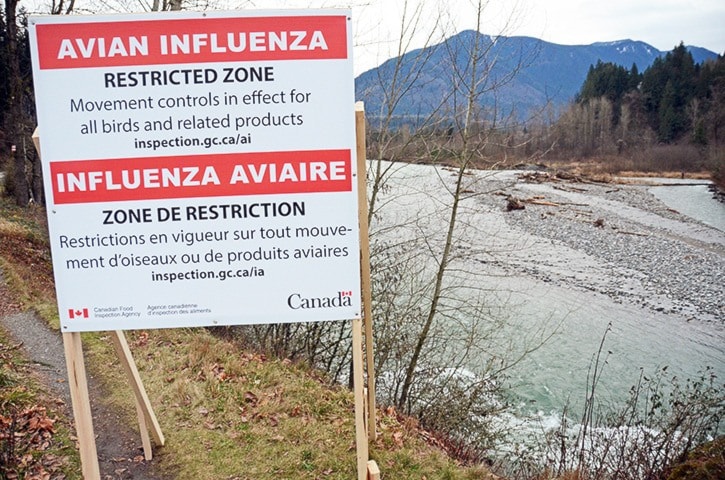The Fraser Valley’s outbreak of avian influenza has now crossed the U.S. border and at least one American expert isn’t impressed with the Canadian Food Inspection Agency’s (CFIA) response.
Biomedical researcher Henry Niman is concerned the highly pathogenic strain will spread throughout North America as wild birds begin winter migration.
No poultry farms in the U.S. were impacted by Wednesday, but the U.S. Department of Agriculture (USDA) reported Tuesday that the H5N2 strain found in Chilliwack, Abbotsford and now Langley has been detected in northern pintail ducks in Lynden, Wash., fewer than 15 kilometres from the Fraser Valley cluster.
“The finding in Whatcom County was quickly reported and identified due to increased surveillance for avian influenza in light of the [highly pathogenic] H5N2 avian influenza affecting commercial poultry in British Columbia, Canada,” said a USDA statement issued Dec. 16.
In addition, a highly pathogenic H5N8 strain was found in Washington in three captive falcons that were fed hunter-killed wild birds.
Niman, who is president of Pittsburgh-based Recombinomics, analyzes viral evolution and the spread of disease.
“The wild birds really can’t be controlled, which is why this is a very big deal that could have a serious impact on poultry markets throughout the Americas,” Niman told the Times.
“Poultry farmers throughout North America should be worried.”
Niman says the CFIA is trying to “manage the message” and downplay concerns, releasing information too slowly, something that could have far-reaching consequences.
As of Friday morning, the CFIA had reported 11 farms in the Fraser Valley affected by the current outbreak. Approximately 245,600 chickens and turkeys have either died from the illness or been euthanized.
The first farm where avian flu was detected was a broiler breeder with 13,000 birds in Chilliwack, although no other farms in the city have been directly impacted by the outbreak. Eight of the other farms affected are in Abbotsford—three turkey and five broiler breeders.
The 10th and largest was a 53,000 table egg layer farm in Langley on Dec. 13. Then on Dec. 17, a second Langley farm, a 11,800-chicken broiler breeder was added to the list.
The CFIA said Wednesday that the H5N8 was the first time a "Eurasian lineage highly pathogenic H5 virus has caused an outbreak of avian influenza in poultry in North America."
"The appearance of this particular reassortant virus is significant due to its ability to cause high mortality in domestic poultry," a Dec. 17 CFIA statement said.
No H5N2 illness has been reported in humans, but the CFIA said that as a precautionary measure, public health officials are monitoring workers who are exposed to affected poultry.
In response to questions from Niman that the CFIA has not acted quickly enough, a spokesperson said the agency "is committed to sharing new information related to the avian influenza situation in a timely manner. The Agency regularly posts updates to the web via the Infected Premises Table, the Timeline of Events, and online statements."
CFIA agrees that wild birds are a problem since they cannot be controlled, which is why biosecurity on farms plays a "very important role."
"Wild birds are certainly a serious concern regarding the spread of this disease as wild birds are natural reservoirs of influenza viruses and have natural migration pathways," the agency said.
The CFIA has not detected either H5N2 or H5N8 in wild birds anywhere in Canada in 2014.
While the illness is not dangerous to people, and the outbreak is likely to have little or no impact on consumers, the industry is feeling the effects as a three-level disease control zone has been set up in the province. The largest primary control zone covers the entire southern half of the province from Highway 16 south. Then there is a restricted zone from that encompassing an area between three and 10 kilometres away from infected farms. Chilliwack residents may have seen signs identifying this zone on the eastern side of Vedder Road closer to the Vedder River. The highest restrictions are in the “infected” zone, the area within three kilometres from any known infected premises, which in Chilliwack means most of Greendale and Yarrow.
“All of this will come out eventually and pretending it isn’t as big as it is doesn’t solve the problem,” Niman said. “Most of the spread will likely be through independent introductions by wild birds, which is very hard to control.”
